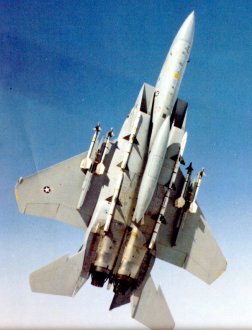The F-15C followed the F-15A on the St.Louis production line and made its first flight on 26 February 1979. It represents an improved and updated derivative of the basic fighter. The two-seat F-15D similarly succeeds the F-15B trainer. F-15C/D Eagles came off the production line with the improved, lightweight Hughes APG-63 X-band pule-Doppler radar with reprogrammable signal processing, and with provision for 750-US gal (2389-litre) CFTs (conformal fuel tanks) on the sides of the intakes.
Previously known as FAST (fuel and sensor, tactical) packs, first demonstrated in 1974 and subsequently sold to Israel, they cannot be jettisoned, but their contents can be dumped, and the fuselage Sparrow stations they displace are duplicated on the outside of the pack itself. Plans for FAST packs containing Wild Weasel avionics equipment were eventually abandoned, and the CFT designation confirms the change to fuel-only.
The prime armament of the baseline F-15C/D remains the AIM-7/9 AAM combination and the same 20-mm M61A1 cannon is retained. The F-15C was intended to be powered by the more powerful Pratt & Whitney F100-PW-220 engine, although early aircraft retained the -100. Minor changes were made to the undercarriage, allowing gross weight to be increased to 68,000 lb (30845 kg). Software changes increased the scope of the 9 g envelope, an important modification since F-15As had effectively been limited to 7.33 g under most circumstances. Changes to the F-15C add about 600 lb (272 kg) to the aircraft's empty weight.
 First blood for the
F-15C was drawn during a period of border tension when two Saudi Arabian F-15Cs shot down
two Iranian F-4E Phantoms over the Persian Gulf on 5 June 1984, possibly the only time one
McDonell fighter scored an arial victory over another. Israeli F-15Cs may also have
notched up kills prior to Desert Storm. When the US launched Operation Desert Shield on 6
August 1990, the 1st TFW at Langley AFB, VA, deployed sweeps. Eagles also flew longer
missions to escort strike aircraft. Quick turn-arounds were a major factor in achieving
high sortie rates, and the F-15C exceeded expectations. No F-15C/D Eagle fighters were
lost during Desert Shield/Storm. More than 2,200 missions totalling some 7,700 hours of
combat time were logged, resulting in thirty two arial victories, two of them scored by a
Saudi pilot of the RSAF's No. 13 Squadron. AMRAAM was infrequently carried, but was not
used in combat.
First blood for the
F-15C was drawn during a period of border tension when two Saudi Arabian F-15Cs shot down
two Iranian F-4E Phantoms over the Persian Gulf on 5 June 1984, possibly the only time one
McDonell fighter scored an arial victory over another. Israeli F-15Cs may also have
notched up kills prior to Desert Storm. When the US launched Operation Desert Shield on 6
August 1990, the 1st TFW at Langley AFB, VA, deployed sweeps. Eagles also flew longer
missions to escort strike aircraft. Quick turn-arounds were a major factor in achieving
high sortie rates, and the F-15C exceeded expectations. No F-15C/D Eagle fighters were
lost during Desert Shield/Storm. More than 2,200 missions totalling some 7,700 hours of
combat time were logged, resulting in thirty two arial victories, two of them scored by a
Saudi pilot of the RSAF's No. 13 Squadron. AMRAAM was infrequently carried, but was not
used in combat.
During the 1990s, F-15 Eagles will continue to undergo staged improvements to radar and internal systems. Firmly comitted to the F-22, the USAF appears to have abondoned plans for a scale-down, improved Eagle known as F-15XX, but an MSIP for the F-15C/D, similar to that for earlier F-15A/B aircraft, is under way. This upgrade program replaces the APG-63 with APG-70 radar, increases memory to 1000 K, trebles processing speed, multiplies central computer capacity by 300 per cent, and adds many improved avionics items. MSIP replaces the original weapons panel with a single Honywell colour TV display. All F-15C/D models are acquiring Tracor AN/ALE-45 chaff/flare dispensers located behind behind the nosewheel door, also found in the F-15E. Northtrop AN/ALQ-135 enhanced internal countermeasures, Loral AN/ALR-56C RWR and Magnavox EW warning system are all incorporated, and JTIDS 2 terminals are to be retrofitted. The MSIP F-15C/D is also compatible with the AIM-120 AMRAAM, which is belatedly replacing the AIM-7 Sparrow as the principal armament for the C/D model Eagle. The MSIP-II changes were flight tested during December 1984, and were applied on production aircraft (beginning with 84-001) during June 1985. F-15C/D aircraft are projected to be in the fighter role until at least 2005.
When F-22s enter service in numbers, the displaced F-15Cs are scheduled to be reworked for defense suppression role. Known as F-15/PDF (Precision Direction Finder), the first contracts for this program have been awarded. The aircraft is intended to supplement F-4Gs and F-16C/Ds in the Wild Weasel role early in the next century.
The F-15C/D has been exported to favored nations Israel, Japan and Saudi Arabia, as detailed under the operators. Japanese F-15J and F-15DJ aircraft are license-built by Mitsubishi.
McDonell Douglas F-15D Eagle
Generally similar to the McDonell Dougles F-15C Eagle except in the following particulars:
Weights: operating empty 29,400 lb (13336 kg).
